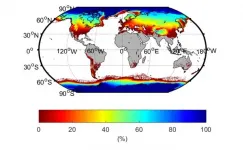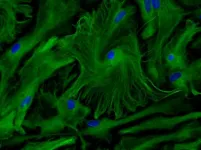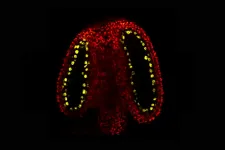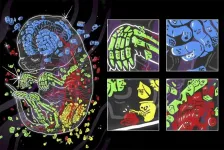(Press-News.org) WASHINGTON--The global cryosphere--all of the areas with frozen water on Earth--shrank by about 87,000 square kilometers (about 33,000 square miles), a area about the size of Lake Superior, per year on average, between 1979 and 2016 as a result of climate change, according to a new study. This research is the first to make a global estimate of the surface area of the Earth covered by sea ice, snow cover and frozen ground.
The extent of land covered by frozen water is just as important as its mass because the bright white surface reflects sunlight so effectively, cooling the planet. Changes in the size or location of ice and snow can alter air temperatures, change the sea level and even affect ocean currents worldwide.
The new study is published in Earth's Future, AGU's journal for interdisciplinary research on the past, present and future of our planet and its inhabitants.
"The cryosphere is one of the most sensitive climate indicators and the first one to demonstrate a changing world," said first author Xiaoqing Peng, a physical geographer at Lanzhou University. "Its change in size represents a major global change, rather than a regional or local issue."
The cryosphere holds almost three-quarters of Earth's fresh water, and in some mountainous regions, dwindling glaciers threaten drinking water supplies. Many scientists have documented shrinking ice sheets, dwindling snow cover and loss of Arctic sea ice individually due to climate change. But no previous study has considered the entire extent of the cryosphere over Earth's surface and its response to warming temperatures.
Contraction in space and time
Peng and his co-authors from Lanzhou University calculated the daily extent of the cryosphere and averaged those values to come up with yearly estimates. While the extent of the cryosphere grows and shrinks with the seasons, they found that the average area covered by Earth's cryosphere has contracted overall since 1979, correlating with rising air temperatures.
The shrinkage primarily occurred in the Northern Hemisphere, with a loss of about 102,000 square kilometers (about 39,300 square miles), or about half the size of Kansas, each year. Those losses are offset slightly by growth in the Southern Hemisphere, where the cryosphere expanded by about 14,000 square kilometers (5,400 square miles) annually. This growth mainly occurred in the sea ice in the Ross Sea around Antarctica, likely due to patterns of wind and ocean currents and the addition of cold meltwater from Antarctic ice sheets.
The estimates showed that not only was the global cryosphere shrinking but that many regions remained frozen for less time. The average first day of freezing now occurs about 3.6 days later than in 1979, and the ice thaws about 5.7 days earlier.
"This kind of analysis is a nice idea for a global index or indicator of climate change," said Shawn Marshall, a glaciologist at the University of Calgary, who was not involved in the study. He thinks that a natural next step would be to use these data to examine when ice and snow cover give Earth its peak brightness, to see how changes in albedo impact the climate on a seasonal or monthly basis and how this is changing over time.
To compile their global estimate of the extent of the cryosphere, the authors divided up the planet's surface into a grid system. They used existing data sets of global sea ice extent, snow cover and frozen soil to classify each cell in the grid as part of the cryosphere if it contained at least one of the three components. Then they estimated the extent of the cryosphere on a daily, monthly and yearly basis and examined how it changed over the 37 years of their study.
The authors say that the global dataset can now be used to further probe the impact of climate change on the cryosphere, and how these changes impact ecosystems, carbon exchange and the timing of plant and animal life cycles.
INFORMATION:
AGU (http://www.agu.org) supports 130,000 enthusiasts to experts worldwide in Earth and space sciences. Through broad and inclusive partnerships, we advance discovery and solution science that accelerate knowledge and create solutions that are ethical, unbiased and respectful of communities and their values. Our programs include serving as a scholarly publisher, convening virtual and in-person events and providing career support. We live our values in everything we do, such as our net zero energy renovated building in Washington, D.C. and our Ethics and Equity Center, which fosters a diverse and inclusive geoscience community to ensure responsible conduct.
Notes for Journalists:
Earth's Future is an open access journal. Download a PDF copy of the paper here. Neither the paper nor this press release is under embargo.
Paper title:
"A Holistic Assessment of 1979-2016 Global Cryospheric Extent"
Authors:
Xiaoqing Peng, Tingjun Zhang (corresponding author), Ran Du, Haodong Jin, and Cuicui Mu (corresponding author), Key Laboratory of Western China's Environmental Systems (Ministry of Education), College of Earth and Environmental Sciences, Lanzhou University, Lanzhou, 730000 China
Oliver W. Frauenfeld, Department of Geography, Texas A&M University, College Station, TX, 77843-3147 USA
People lived without plastic until the last century or so, but most of us would find it hard to imagine how.
Plastics now are everywhere in our lives, providing low-cost convenience and other benefits in countless applications. They can be shaped to almost any task, from wispy films to squishy children's toys and hard-core components. They have shown themselves vital in medicine and have been pivotal in the global effort to slow the spread of the COVID-19 pandemic over the past 16 months.
Plastics seem indispensable these days.
Unfortunately for the long-term, they are also nearly indestructible. Our planet now bears the weight of more than seven billion tons ...
As smart watches are increasingly able to monitor the vital signs of health, including what's going on when we sleep, a problem has emerged: those wearable, wireless devices are often disconnected from our body overnight, being charged at the bedside.
"Quality of sleep and its patterns contain a lot of important information about patients' health conditions," says Sunghoon Ivan Lee, assistant professor in the University of Massachusetts Amherst College of Information and Computer Sciences and director of the Advanced Human Health Analytics Laboratory.
But that information can't be tracked on smartwatches if the wearable devices are ...
Over years of studying antibody responses against the flu in the Wilson lab at the University of Chicago, researchers kept coming up with a strange finding: antibodies that seemed to bind not only to the flu virus, but to every virus the lab could throw at them. Since antibodies are usually highly specific to individual pathogens, in order to maximize their targeted protective response, this pattern was extremely unusual.
Until finally, they realized: The antibodies weren't responding to the viruses, but rather to something in the biological material in which the viruses had been grown. ...
Astrocytes are cells in the brain which have long been considered only as mere support cells for neurons. In recent years, the study of astrocytes has grown, gradually revealing their importance in brain function. Researchers from Inserm, CNRS and Collège de France at the Center for Interdisciplinary Research in Biology have now uncovered their crucial role in closing the period of brain plasticity that follows birth, finding them to be key to the development of sensory and cognitive faculties. Over the longer term, these findings will make it possible to envisage new strategies for reintroducing brain plasticity in adults, thereby promoting rehabilitation following brain lesions or neurodevelopmental disorders. This research has been published in Science.
Brain plasticity is ...
Hereditary information is passed from parent to offspring in the genetic code, DNA, and epigenetically through chemically induced modifications around the DNA.
New research from the John Innes Centre has uncovered a mechanism which adjusts these modifications, altering the way information beyond the genetic code is passed down the generations.
DNA methylation, one example of these epigenetic modifications, happens when a methyl group or chemical cap is added to the DNA, switching a gene, or genes, on or off.
As germline (eggs and sperm) cells develop some of the methyl markers are reset, affecting the information passed onto the next generation.
How this process ...
Although plastics have become an essential material, permeating almost all aspects of modern living, many of the inherent properties that make them useful in such a wide variety of applications also make them a serious environmental threat. In a special issue of Science, "Our Plastics Dilemma," four Reviews, two Perspectives, a Policy Forum, an associated Report and two News features examine a wide range of topics related to plastics and the problems they present. "As for much new technology, their development and proliferation occurred with little consideration for their impacts, but now it's impossible to deny their dark side as we confront a rapidly ...
Through the sequencing of more than 640,000 human exomes, researchers identify rare gene coding variants strongly associated with body mass index (BMI) - including the variant GPR75, which conferred protection from obesity in mouse models. Not only do the findings provide potential therapeutic targets for treating obesity, but they also demonstrate the power and versatility of massive-scale exome sequencing in discovering rare coding variants that could offer new and potentially translatable biological functions. Body fat is a highly heritable trait and the obesity to which body ...
Researchers could not confirm that a feature that supposedly signals the presence of Majorana bound states - the unusual quasiparticles that may become the cornerstone of topological quantum computing - was in fact due to elusive Majorana particles, in full-shell semiconductor/superconductor nanowires. Rather, this feature, known as zero bias conductance peak, can arise from another quantum phenomenon in these hybrid nanowire structures, the authors say. In recent years, intense research has been conducted on nanowire-based semiconductor-superconductor hybrid systems because predictions suggest that a topological superconductor state with Majorana zero modes (MZMs) can be engineered from them. Even though several experiments in such platforms have reported ...
Researchers introduce "sci-Space," a new approach to spatial transcriptomics that can retain single-cell resolution and spatial heterogeneity at scales much larger than previous methods. They used their approach to build single-cell atlases of whole sections of mouse embryos at 14 days of development. Single-cell RNA sequencing methods have led to great advances in understanding how organisms and complex tissues develop. Although cells' spatial organization is central to normal development, homeostasis, and pathophysiology, many single-cell RNA sequencing methods lose valuable contextual spatial information. Those that preserve spatial context between cells can be limited to a specific set of genes and/or ...
A new technique called sci-Space, combined with data from other technologies, could lead to four-dimensional atlases of gene expression across diverse cells during embryonic development of mammals.
Such atlases would map how the gene transcripts in individual cells reflect the passage of time, cell lineages, cell migration, and location on the developing embryo. They would also help illuminate the spatial regulation of gene expression.
Mammalian embryonic development is a remarkable phenomenon: a fertilized egg divides repeatedly and turns, in a matter of weeks or months, into a complex organism capable of a myriad of physiological processes and composed of a variety ...





